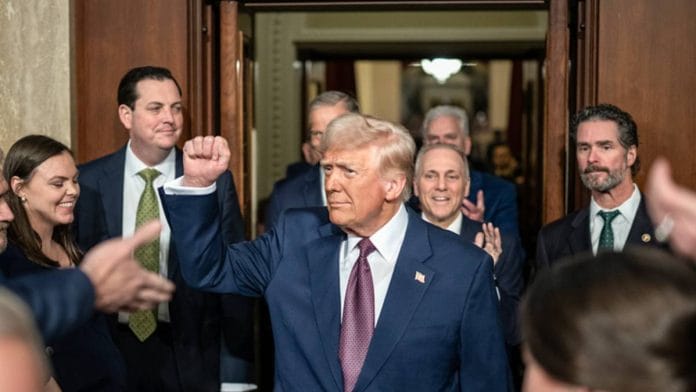New Delhi: US President Donald Trump late Wednesday pulled back from the additional tariffs imposed on partners and allies, while hiking duties on China to 125 percent, in the trade war unleashed by his administration last week. Trump faced pushback from Wall Street and some of his allies as the tariffs hit US markets.
“Conversely, and based on the fact that more than 75 Countries have called Representatives of the United States, including the Departments of Commerce, Treasury, and the USTR, to negotiate a solution to the subjects being discussed relative to Trade, Trade Barriers, Tariffs, Currency Manipulation, and Non-Monetary Tariffs, and that these Countries have not, at my strong suggestion, retaliated in any way, shape, or form against the United States, I have authorised a 90-day PAUSE, and a substantially lowered Reciprocal Tariff during this period, of 10%, also effective immediately,” said Trump in a post on his social media platform Truth Social.
The reversal by Trump comes hours after the bruising tariffs, which saw 27 percent reciprocal tariffs or import duties on Indian goods, or in some cases even 40 percent or higher on partners and allies like Vietnam and the European Union (EU), led to fears of a recession in American markets.
The US administration faced pushback, with bankers including JPMorgan Chase CEO Jamie Dimon highlighting the uncertainties surrounding the markets following Trump’s “Liberation Day” tariffs.
While Trump paused the additional levies on more than 60 countries, he raised those on China from 104 percent to 125 percent, following Beijing’s imposition of 84 percent tariffs on American goods a few hours earlier. The baseline tariff of 10 percent on all goods remains unchanged.
“Based on the lack of respect that China has shown to the World’s Markets, I am hereby raising the Tariff charged to China by the United States of America to 125%, effective immediately. At some point, hopefully in the near future, China will realise that the days of ripping off the USA, and other Countries, is no longer sustainable or acceptable,” said Trump on the new tariffs on China.
The announcement came in time to lead a rally by the US stock markets, with the S&P 500 rising more than 9 percentage points, its best rally since the 2008 global financial crisis. The tariffs also set off a sharp sell-off in US government bond markets and the dollar. These are normally seen as the safest investment options during times of economic crises.
The course reversal on tariffs led to a surge in Asian stock markets too, with Japan’s Nikkei surging by 8 percent Thursday. The BSE Sensex and NSE NIFTY 50 both closed in the red Wednesday.
Also Read: Is Trump being too radical in defying economic sanity? Think Narendra Modi and demonetisation
India continues to push for a deal
Hours after the additional tariffs were first imposed, India maintained that it was “assessing” the situation and working to conclude the bilateral trade agreement “expeditiously” with Washington.
“India is carefully examining the implications of the various announcements made by the US. The government of India remains engaged with all stakeholders and is assessing the situation by taking into account feedback from stakeholders, including exporters and industry representatives,” said Randhir Jaiswal, spokesperson for the Ministry of External Affairs (MEA) Wednesday, during a regular press briefing.
“Discussions are ongoing between Indian and US trade teams for the expeditious conclusion of a mutually beneficial, multi-sectoral bilateral trade agreement. India values its comprehensive global strategic partnership with the US and is committed to working closely with it,” he added.
The bilateral trade agreement was first agreed to by Prime Minister Narendra Modi and Trump during the former’s visit to the White House in February this year. At the end of March, a US delegation led by Assistant Trade Representative for South and Central Asia Brendan Lynch arrived in New Delhi and held extensive discussions with their Indian counterparts.
The two sides are engaging sectoral experts currently, and are hoping to finish the first tranche of the deal by autumn of this year.
(Edited by Nida Fatima Siddiqui)
Also Read: Trump is playing the ‘commitment game’. India must be smart, not surrender






